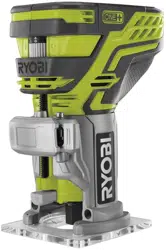Loading ...
Loading ...
Loading ...

10
■ The cutting diameter of the bit. Maximum bit size for
roundover and edging operations is 9.53mm (3/8”)
max. Maximum straight bit size for rabbeting and dado
operations is 6.35mm (1/4”).
For edge shaping in soft woods such as pine, a faster rate
of feed can be used. When edge shaping in hardwoods
such as oak, a slower rate of feed will be required. In all
wood types, a slower rate of feed is required when cutting
shallow grooves.
Several factors will help you select the proper rate of feed.
■ Choose a rate that does not slow down the trimmer
motor.
■ Choose the rate of feed at which the bit advances firmly
and surely to produce a continuous spiral of uniform
chips or a smooth trim edge on laminate.
■ Listen to the sound of the trimmer motor. A high-
pitched, strained sound means you are feeding too fast.
■ Check the progress of each cut. Too-slow feeding can
cause the trimmer to take off in a wrong direction from
the intended line of cut. Force-feeding increases the
strain of holding the tool and can result in damage to
the tool.
■ Notice the chips being produced as you cut. If the
trimmer is fed too slowly, it will scorch or burn the wood.
If the trimmer is fed too fast, it will take large chips out
of the wood and leave gouge marks.
Always test a cut on scrap piece of the workpiece wood
or laminate before you begin. Always grasp and hold the
trimmer rmly when trimming.
When using the largest recommended straight bit 6.35mm
(1/4”) in any type of wood, maintain a maximum cutting
depth of 3.18mm (1/8”) and a very slow feed rate to
achieve the best quality cut. A cross-grain cut requires a
slower pace than an identical cut with the grain in the same
workpiece.
There is no xed rule. Proper feed rate is learned through
practice and use.
FORCE FEEDING
See Figure 10.
The trimmer is an extremely high-speed tool (29,000 min
-1
.),
and will make clean, smooth cuts if allowed to run freely without
the overload of a forced feed. Three things that cause force
feeding are bit size, depth of cut, and workpiece characteristics.
The larger the bit or the deeper the cut, the more slowly the
trimmer should be moved forward. If the wood is very hard,
knotty, gummy or damp, the operation must be slowed still
more.
Clean smooth trimming and edge shaping can be done
only when the bit is revolving at a relatively high speed and
is taking very small bites to produce tiny, cleanly-severed
chips. If the trimmer is forced to move forward too fast, the
speed of the bit becomes slower than normal in relation to
its forward movement. As a result, the bit must take bigger
bites as it revolves. Bigger bites mean bigger chips and a
rougher nish. Bigger chips also require more power, which
could result in overheating of the motor and lower battery
life.
Under extreme force-feeding conditions, the relative speed
of the bit can become so slow – and the bites it has to take
so large – that chips will be partially knocked off rather than
fully cut off. This will result in splintering and gouging of the
workpiece and will likely damage the tool.
TOO SLOW FEEDING
See Figure 10.
When the trimmer is advanced into the work too slowly
it scrapes away sawdust-like particles instead of cleanly
cutting into the workpiece. Scraping produces heat, which
can glaze, burn, or mar the cut, and can overheat the bit.
Dull bits can also contribute to scraping and burning.
It is more difcult to control a trimmer when the bit is
scraping instead of cutting. With practically no load on the
motor, the bit will be revolving near top RPM. When feeding
too slowly, the bit will have a greater than normal tendency
to bounce off the sides of the cut, especially if the wood has
a pronounced grain with hard and soft areas. The cut that
results may have rippled sides instead of straight.
DEPTH OF CUT
See Figure 11.
Depth of cut affects the rate of feed and the quality of a cut.
Using the proper depth of cut can lessen the possibility of
damage to the trimmer motor and bit.
A deeper cut requires a slower feed than a shallow one.
Making a cut that is too deep will slow the feed so that the
bit is scraping, rather than cutting, and is not recommended.
A too-deep cut can cause smaller bits to be broken off. bits
that are 1.6mm (1/16”) in diameter are easily broken off
when subjected to too much side thrust. A larger bit is not
as likely to break, but attempting a cut that is too deep may
result in a rough cut, and may make it difcult to guide and
control the bit as desired.
It is necessary that you do not exceed 3.18mm (1/8”) depth
of cut in a single pass, regardless of the bit size or the
softness or condition of the workpiece. This will result in a
higher quality cut.
To make deeper cuts, it is necessary to make as many
successive passes as required, lowering the bit 3.18mm
(1/8”) for each new pass. To save time, perform all the
cutting necessary at one depth setting, then lower the bit
for the next pass. This will assure uniform depth when the
nal pass is completed.
WARNING
If the desired depth of cut is greater than can be safely
cut in one pass, make cuts in two or more passes. Do
not remove more than 3.18mm (1/8”) in a single pass.
Excessive depth of cut can result in loss of control and
the possibility of serious personal injury.
Loading ...
Loading ...
Loading ...
